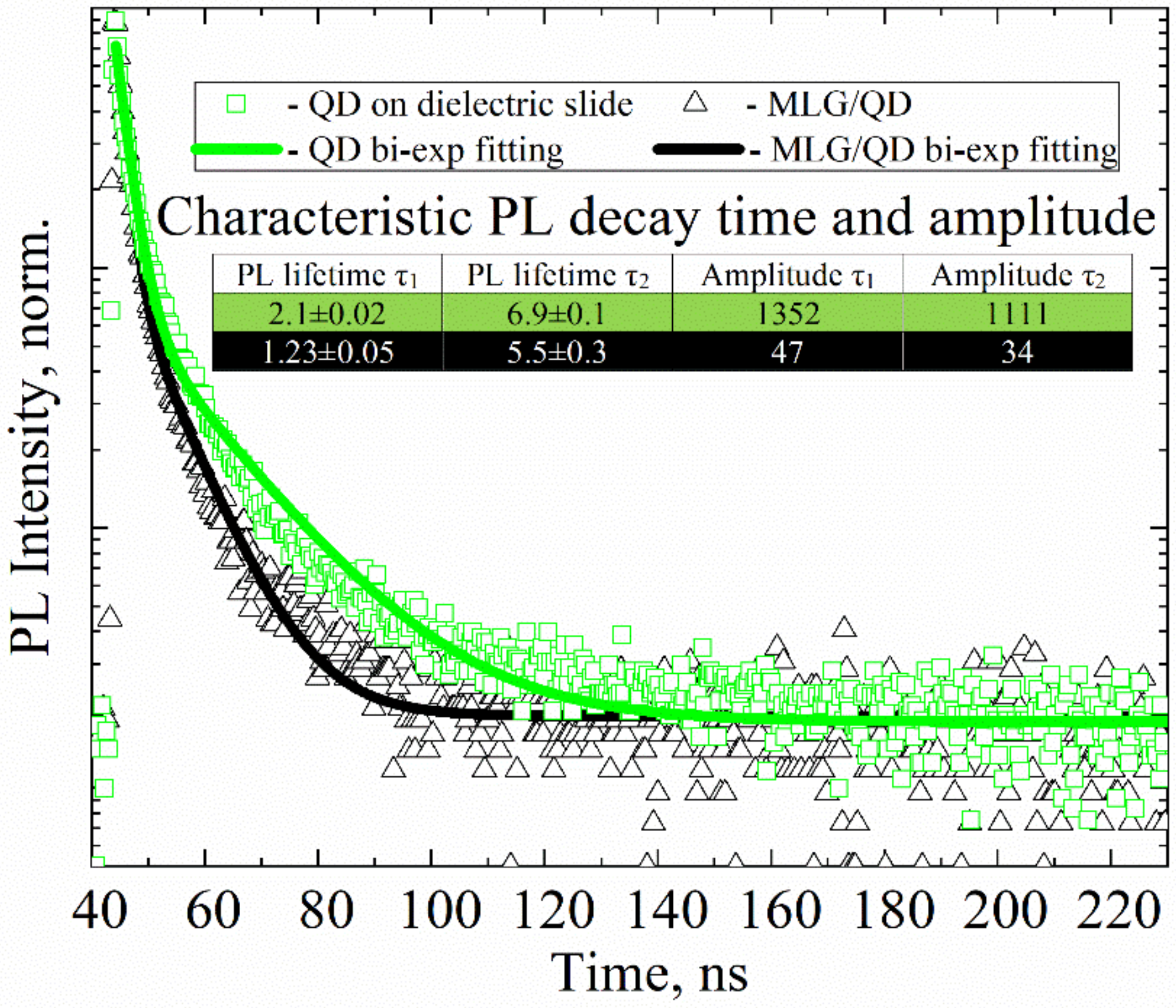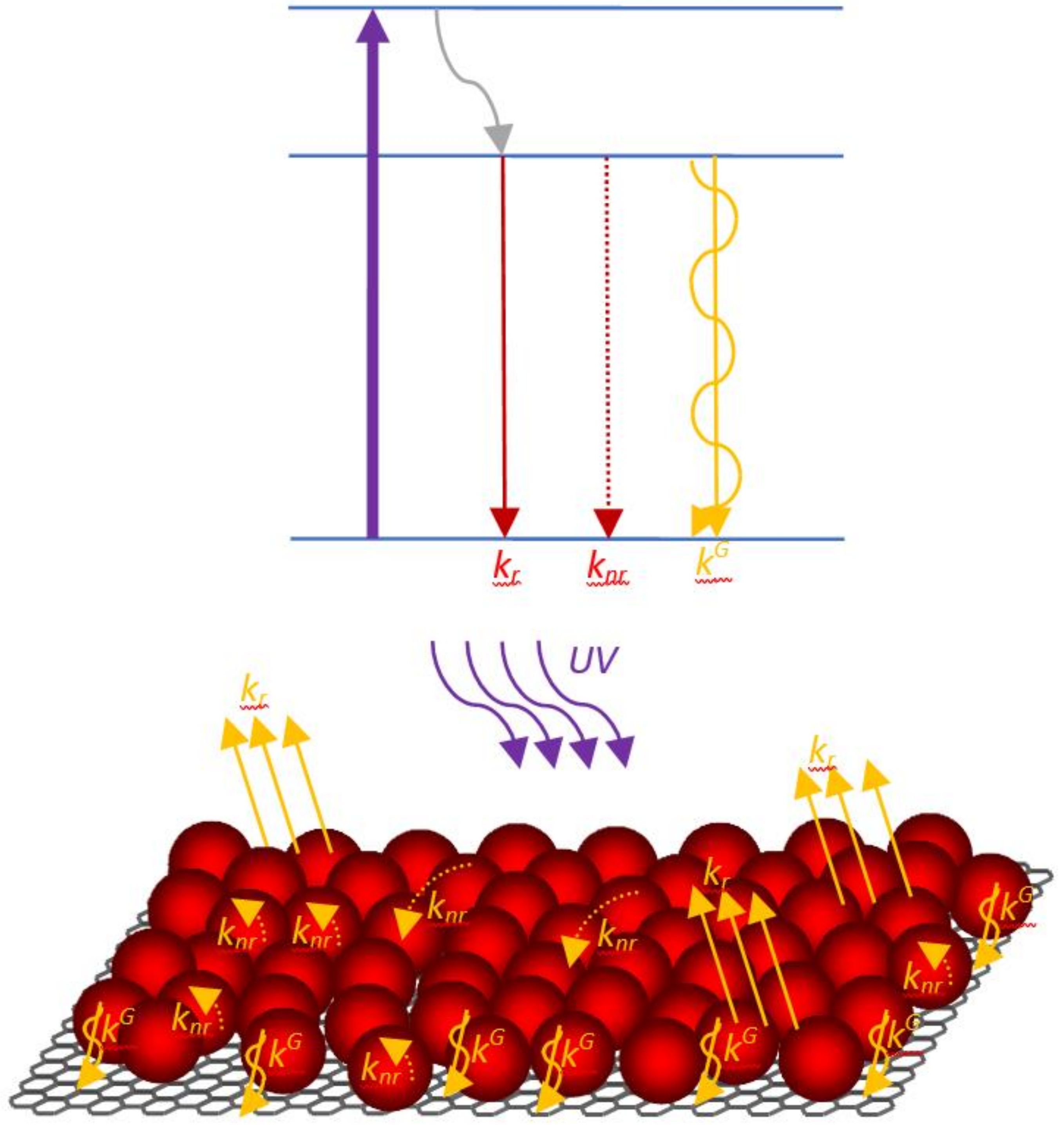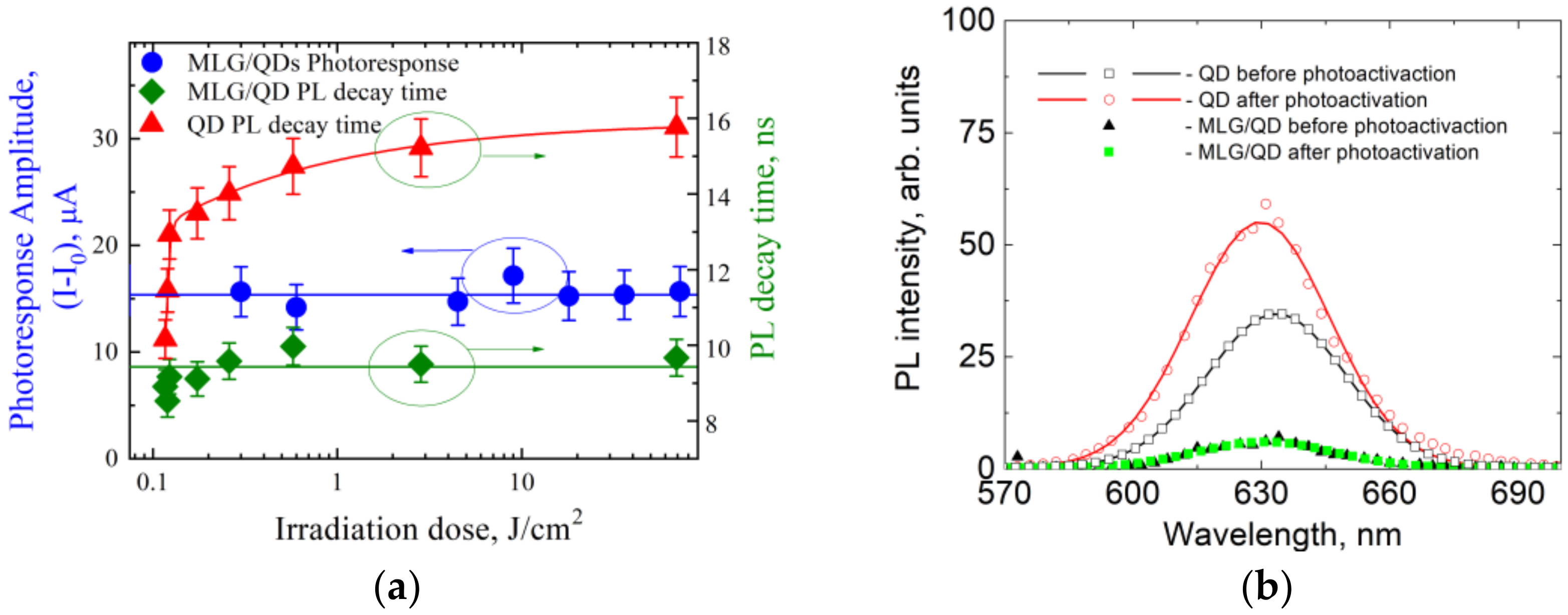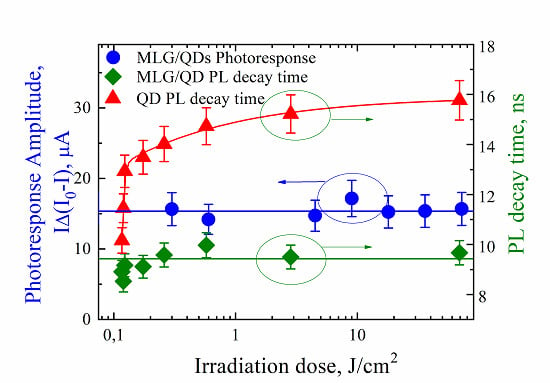Photophysical Properties of Multilayer Graphene–Quantum Dots Hybrid Structures
Abstract
1. Introduction
2. Materials and Methods
2.1. Materials
2.2. Ligand Exchange Procedure
2.3. Formation of MLG–QD Hybrid Structures Layered on Slides
2.4. Characterization of the Structures
3. Results and Discussion
3.1. PL Kinetics of CdSe QDs in MLG–QD Structures
3.2. Photoelectric Properties of MLG–QD Hybrid Structures
3.3. Photoactivation of MLG–QD Hybrid Structures
4. Conclusions
Supplementary Materials
Author Contributions
Funding
Acknowledgments
Conflicts of Interest
References
- Moraitis, P.; Schropp, R.E.; van Sark, W.G.J.H.M. Nanoparticles for luminescent solar concentrators-a review. Opt. Mater. 2018, 84, 636–645. [Google Scholar] [CrossRef]
- Jeevanandam, J.; Barhoum, A.; Chan, Y.S.; Dufresne, A.; Danquah, M.K. Review on nanoparticles and nanostructured materials: History, sources, toxicity and regulations. Beilstein J. Nanotechnol. 2018, 9, 1050–1074. [Google Scholar] [CrossRef] [PubMed]
- Jariwala, D.; Sangwan, V.K.; Lauhon, L.J.; Marks, T.J.; Hersam, M.C. Carbon nanomaterials for electronics, optoelectronics, photovoltaics, and sensing. Chem. Soc. Rev. 2013, 42, 2824–2860. [Google Scholar] [CrossRef] [PubMed]
- Bai, Y.; Mora-Sero, I.; De Angelis, F.; Bisquert, J.; Wang, P. Titanium dioxide nanomaterials for photovoltaic applications. Chem. Rev. 2014, 114, 10095–10130. [Google Scholar] [CrossRef]
- Chen, G.; Seo, J.; Yang, C.; Prasad, P.N. Nanochemistry and nanomaterials for photovoltaics. Chem. Soc. Rev. 2013, 42, 8304–8338. [Google Scholar] [CrossRef]
- Pankhurst, Q.A.; Connolly, J.; Jones, S.K.; Dobson, J. Applications of magnetic nanoparticles in biomedicine. J. Phys. D Appl. Phys. 2003, 36, 167–181. [Google Scholar] [CrossRef]
- Xie, B.; Hu, R.; Luo, X. Quantum dots-converted light-emitting diodes packaging for lighting and display: Status and perspectives. J. Electron. Packag. 2016, 138, 020803:1–020803:13. [Google Scholar] [CrossRef]
- Carey, G.H.; Abdelhady, A.L.; Ning, Z.; Thon, S.M.; Bakr, O.M.; Sargent, E.H. Colloidal quantum dot solar cells. Chem. Rev. 2015, 115, 12732–12763. [Google Scholar] [CrossRef]
- Li, X.; Rui, M.; Song, J.; Shen, Z.; Zeng, H. Carbon and graphene quantum dots for optoelectronic and energy devices: A review. Adv. Funct. Mater. 2015, 25, 4929–4947. [Google Scholar] [CrossRef]
- Dabbousi, B.O.; Rodriguez-Viejo, J.; Mikulec, F.V.; Heine, J.R.; Mattoussi, H.; Ober, R.; Jensen, K.F.; Bawendi, M.G. (CdSe) ZnS core−shell quantum dots: Synthesis and characterization of a size series of highly luminescent nanocrystallites. J. Phys. Chem. B 1997, 101, 9463–9475. [Google Scholar] [CrossRef]
- Kim, S.; Fisher, B.; Eisler, H.-J.; Bawendi, M. Type-II quantum dots: CdTe/CdSe (core/shell) and CdSe/ZnTe (core/shell) heterostructures. J. Am. Chem. Soc. 2003, 125, 11466–11467. [Google Scholar] [CrossRef]
- Bera, D.; Qian, L.; Tseng, T.-K.; Holloway, P.H. Quantum dots and their multimodal applications: A review. Materials 2010, 3, 2260–2345. [Google Scholar] [CrossRef]
- Asryan, L.V.; Suris, R.A. Inhomogeneous line broadening and the threshold current density of a semiconductor quantum dot laser. Semicond. Sci. Tech. 1996, 11, 554–567. [Google Scholar] [CrossRef]
- Zhang, C.; Palui, G.; Zeng, B.; Zhan, N.; Chen, B.; Mattoussi, H. Non-Invasive Characterization of the Organic Coating of Biocompatible Quantum Dots Using Nuclear Magnetic Resonance Spectroscopy. Chem. Mater. 2018, 30, 3454–3466. [Google Scholar] [CrossRef]
- Shrestha, A.; Batmunkh, M.; Tricoli, A.; Qiao, S.Z.; Dai, S. Near-Infrared Active Lead Chalcogenide Quantum Dots: Preparation, Post-Synthesis Ligand Exchange, and Applications in Solar Cells. Angew. Chem. Int. Edit. 2019, 58, 5202–5224. [Google Scholar] [CrossRef] [PubMed]
- Medintz, I.L.; Uyeda, H.T.; Goldman, E.R.; Mattoussi, H. Quantum dot bioconjugates for imaging, labelling and sensing. Nat. Mater. 2005, 4, 435–446. [Google Scholar] [CrossRef]
- Zhang, H.; Huang, H.; Ming, Y.; Li, H.; Zhang, L.; Liu, Y.; Kang, Z. Carbon quantum dots/Ag3PO4 complex photocatalysts with enhanced photocatalytic activity and stability under visible light. J. Mater. Chem. 2012, 22, 10501–10506. [Google Scholar] [CrossRef]
- Ren, S.; Chang, L.Y.; Lim, S.K.; Zhao, J.; Smith, M.; Zhao, N.; Bulović, V.; Bawendi, M.; Gradecak, S. Inorganic–organic hybrid solar cell: Bridging quantum dots to conjugated polymer nanowires. Nano Lett. 2011, 11, 3998–4002. [Google Scholar] [CrossRef]
- Biju, V.; Itoh, T.; Abdulaziz, A.; Athiyanathil, S.; Ishikawa, M. Semiconductor quantum dots and metal nanoparticles: Syntheses, optical properties, and biological applications. Anal. Bioanal. Chem. 2008, 391, 2469–2495. [Google Scholar] [CrossRef]
- De Freitas, J.N.; Grova, I.R.; Akcelrud, L.C.; Arici, E.; Serdar Sariciftcic, N.; Nogueira, A.F. The effects of CdSe incorporation into bulk heterojunction solar cells. J. Mater. Chem. 2010, 20, 4845–4853. [Google Scholar] [CrossRef]
- Ataca, C.; Şahin, H.; Aktürk, E.; Ciraci, S. Mechanical and electronic properties of MoS2 nanoribbons and their defects. J. Phys. Chem. C 2011, 115, 3934–3941. [Google Scholar] [CrossRef]
- Ke, Q.; Wang, J. Graphene-based materials for supercapacitor electrodes–A review. J. Materiomics 2016, 2, 37–54. [Google Scholar] [CrossRef]
- Lin, Y.; Zhang, K.; Chen, W.; Liu, Y.; Geng, Z.; Zeng, J.; Pan, N.; Yan, L.; Wang, X.; Hou, J.G. Dramatically enhanced photoresponse of reduced graphene oxide with linker-free anchored CdSe nanoparticles. ACS Nano 2010, 4, 3033–3038. [Google Scholar] [CrossRef] [PubMed]
- Xiao, F.X.; Miao, J.; Liu, B. Layer-by-layer self-assembly of CdS quantum dots/graphene nanosheets hybrid films for photoelectrochemical and photocatalytic applications. J. Am. Chem. Soc. 2014, 136, 1559–1569. [Google Scholar] [CrossRef] [PubMed]
- Fang, Y.; Lv, Y.; Tang, J.; Wu, H.; Jia, D.; Feng, D.; Kong, B.; Wang, Y.; Elzatahry, A.A.; Al-Dahyan, D.; et al. Growth of Single-Layered Two-Dimensional Mesoporous Polymer/Carbon Films by Self-Assembly of Monomicelles at the Interfaces of Various Substrates. Angew. Chem. Int. Edit. 2015, 127, 8545–8549. [Google Scholar] [CrossRef]
- Chen, W.; Xiao, P.; Chen, H.; Zhang, H.; Zhang, Q.; Chen, Y. Polymeric graphene bulk materials with a 3D cross-linked monolithic graphene network. Adv. Mater. 2019, 31, 1802403:1–1802403:15. [Google Scholar] [CrossRef]
- Carrillo-Carrión, C.; Cárdenas, S.; Simonet, B.M.; Valcárcela, M. Quantum dots luminescence enhancement due to illumination with UV/Vis light. Chem. Comm. 2009, 35, 5214–5226. [Google Scholar] [CrossRef]
- Kolesova, E.P.; Maslov, V.G.; Gun’ko, Y.K.; Orlova, A.O. Photoinduced increase of electron transfer efficiency of QDs based hybrid structures. Proc. SPIE 2019, 11207, 437–442. [Google Scholar] [CrossRef]
- Märker, B.; Hiller, J.; Wackenhut, F.; Braun, K.; Meixner, A.; Scheele, M. Simultaneous positive and negative optical patterning with dye-sensitized CdSe quantum dots. J. Chem. Phys. 2019, 151, 141102:1–141102:6. [Google Scholar] [CrossRef]
- Cordero, S.R.; Carson, P.J.; Estabrook, R.A.; Strouse, G.F.; Buratto, S.K. Photo-activated luminescence of CdSe quantum dot monolayers. J. Phys. Chem. B 2000, 104, 12137–12142. [Google Scholar] [CrossRef]
- Pechstedt, K.; Whittle, T.; Baumberg, J.; Melvin, T. Photoluminescence of colloidal CdSe/ZnS quantum dots: The critical effect of water molecules. J. Phys. Chem. C 2010, 114, 12069–12077. [Google Scholar] [CrossRef]
- Bawendi, M.G.; Carroll, P.J.; Wilson, W.L.; Brus, L.E. Luminescence properties of CdSe quantum crystallites: Resonance between interior and surface localized states. J. Chem. Phys. 1992, 96, 946–954. [Google Scholar] [CrossRef]
- Gaponik, N.; Talapin, D.V.; Rogach, A.L.; Hoppe, K.; Shevchenko, E.V.; Kornowski, A.; Eychmüller, A.; Weller, H. Thiol-capping of CdTe nanocrystals: An alternative to organometallic synthetic routes. J. Phys. Chem. B 2002, 106, 7177–7185. [Google Scholar] [CrossRef]
- Bao, H.; Gong, Y.; Li, Z.; Gao, M. Enhancement effect of illumination on the photoluminescence of water-soluble CdTe nanocrystals: Toward highly fluorescent CdTe/CdS core-shell structure. Chem. Mater. 2004, 16, 3853–3859. [Google Scholar] [CrossRef]
- Reiss, P.; Bleuse, J.; Pron, A. Highly luminescent CdSe/ZnSe core/shell nanocrystals of low size dispersion. Nano Lett. 2002, 2, 781–784. [Google Scholar] [CrossRef]
- Kannan, P.K.; Moshkalev, S.A.; Rout, C.S. Highly sensitive and selective electrochemical dopamine sensing properties of multilayer graphene nanobelts. Nanotechnology 2016, 27, 075504:1–075504:9. [Google Scholar] [CrossRef]
- Justo, Y.; Moreels, I.; Lambert, K.; Hens, Z. Langmuir–Blodgett monolayers of colloidal lead chalcogenide quantum dots: Morphology and photoluminescence. Nanotechnology 2010, 21, 295606:1–295606:6. [Google Scholar] [CrossRef]
- Black, A.; Roberts, J.; Acebrón, M.; Bernardo-Gavito, R.; Alsharif, G.; Urbanos, F.J.; Juárez, B.H.; Kolosov, O.V.; Robinson, B.J.; Miranda, R.; et al. Large-Area Heterostructures from Graphene and Encapsulated Colloidal Quantum Dots via the Langmuir–Blodgett Method. ACS Appl. Mater. Int. 2018, 10, 6805–6809. [Google Scholar] [CrossRef]
- Peng, X.; Manna, L.; Yang, W.; Wickham, J.; Scher, E.; Kadavanich, A.; Alivisatos, A.P. Shape control of CdSe nanocrystals. Nature 2000, 404, 59–61. [Google Scholar] [CrossRef]
- Fedorov, A.V.; Kruchinin, S.Y.; Baranov, A.V.; Maslov, V.G.; Orlova, A.O. Energy transfer of electronic photo-excitations in semiconductor quantum dots. In Proceedings of the International Conference Fundamentals of Laser Assisted Micro– & Nanotechnologies (FLAMN-07), St. Petersburg, Russia, 25–28 June 2007; p. 132. [Google Scholar]
- Yuan, G.; Gómez, D.E.; Kirkwood, N.; Boldt, K.; Mulvaney, P. Two mechanisms determine quantum dot blinking. ACS Nano 2018, 12, 3397–3405. [Google Scholar] [CrossRef]
- Brokmann, X.; Coolen, L.; Dahan, M.; Hermier, J.P. Measurement of the radiative and nonradiative decay rates of single CdSe nanocrystals through a controlled modification of their spontaneous emission. Phys. Rev. Lett. 2004, 93, 107403:1–107403:4. [Google Scholar] [CrossRef] [PubMed]
- Gromova, Y.A.; Reznik, I.A.; Vovk, I.A.; Rackauskas, S.; Alaferdov, A.V.; Orlova, A.O.; Moshkalev, S.A.; Baranov, A.V.; Fedorov, A.V. Photoinduced conductivity enhancement in quantum dot/multilayer graphene nanostructures. Mater. Res. Soc. Symp. Proc. 2015, 1787, 15–19. [Google Scholar] [CrossRef]
- Reznik, I.A.; Gromova, Y.A.; Zlatov, A.S.; Baranov, M.A.; Orlova, A.O.; Moshkalev, S.A.; Maslov, V.G.; Baranov, A.V.; Fedorov, A.V. Hybrid structures based on quantum dots and graphene nanobelts. Opt. Spectrosc. 2017, 122, 114–119. [Google Scholar] [CrossRef]
- Xia, F.; Mueller, T.; Lin, Y.M.; Valdes-Garcia, A.; Avouris, P. Utrafast graphene photodetector. Nat. Nanotech. 2009, 4, 839–843. [Google Scholar] [CrossRef]
- Gromova, Y.; Alaferdov, A.; Rackauskas, S.; Ermakov, V.; Orlova, A.O.; Maslov, V.; Moshkalev, S.A.; Baranov, A.V.; Fedorov, A.V. Photoinduced electrical response in quantum dots/graphene hybrid structure. J. Appl. Phys. 2015, 118, 104305:1–104305:6. [Google Scholar] [CrossRef]
- Saha, S.K.; Baskey, M.; Majumdar, D. Graphene quantum sheets: A new material for spintronic applications. Adv. Mater. 2010, 22, 5531–5536. [Google Scholar] [CrossRef]
- Rogach, A.L.; Franzl, T.; Klar, T.A.; Feldmann, J.; Gaponik, N.; Lesnyak, V.; Shavel, A.; Eychmüller, A.; Rakovich, Y.P.; Donegan, J.F. Aqueous synthesis of thiol-capped CdTe nanocrystals: State-of-the-art. J. Phys. Chem. C 2007, 111, 14628–14637. [Google Scholar] [CrossRef]
- Farmer, D.B.; Golizadeh-Mojarad, R.; Perebeinos, V.; Lin, Y.-M.; Tulevski, G.S.; Tsang, J.C.; Avouris, P. Chemical doping and electron−hole conduction asymmetry in graphene devices. Nano Lett. 2009, 9, 388–392. [Google Scholar] [CrossRef]
- Moon, H.; Lee, C.; Lee, W.; Kim, J.; Chae, H. Stability of Quantum Dots, Quantum Dot Films, and Quantum Dot Light-Emitting Diodes for Display Applications. Adv. Mater. 2019, 34, 1804294:1–1804294:14. [Google Scholar] [CrossRef]




| Samples | Characteristics |
|---|---|
| MLG | Multilayered graphene nanobelts with 30–40 nm thickness deposited on a glass slide with titanium contacts |
| QDs | 5.5 nm core–shell CdSe–ZnS QD monolayer deposited on a glass slide from toluene solution |
| MLG–QDs | Hybrid structures with 5.5 nm core–shell CdSe–ZnS QD monolayer deposited on the MLG on a glass slide with titanium contacts |
| Samples | Parameters | Units | 1st QD fraction | 2nd QD fraction | Formula |
|---|---|---|---|---|---|
| CdSe–ZnS QDs monolayer | kr | s−1 | 0.4 × 108 | - | |
| φi | % | 8.4 | 27.7 | (5) | |
| τiQD | ns | 2.1 ± 0.1 | 6.9 ± 0.1 | - | |
| Ai | Counts | 1350 ± 50 | 1100 ± 50 | - | |
| knr | s−1 | 4.3 × 108 | 1.0 × 108 | (4) | |
| Hybrid structures | τiG | ns | 1.2 ± 0.1 | 5.5 ± 0.3 | - |
| Ai | Counts | 47 ± 2 | 34 ± 2 | - | |
| kiG | s−1 | (3.4 ± 0.2) × 108 | (0.40 ± 0.05) × 108 | (7) | |
| QiG | % | 98 ± 2 | 97.5 ± 2 | (6) | |
| QG | % | 98 ± 2 | (6) | ||
| Samples | Stage II | Stage III | ||
|---|---|---|---|---|
| AII, μA | tII, s | AIII, μA | tIII, s | |
| MLG | 2.5 ± 0.15 | 0.25 ± 0.03 | 5.9 ± 0.1 | 5.1 ± 0.3 |
| MLG–QD Hybrid structures | 4.4 ± 0.15 | 0.31 ± 0.02 | 11.1 ± 0.1 | 5.3 ± 0.2 |
© 2020 by the authors. Licensee MDPI, Basel, Switzerland. This article is an open access article distributed under the terms and conditions of the Creative Commons Attribution (CC BY) license (http://creativecommons.org/licenses/by/4.0/).
Share and Cite
Reznik, I.; Zlatov, A.; Baranov, M.; Zakoldaev, R.; Veniaminov, A.; Moshkalev, S.; Orlova, A. Photophysical Properties of Multilayer Graphene–Quantum Dots Hybrid Structures. Nanomaterials 2020, 10, 714. https://doi.org/10.3390/nano10040714
Reznik I, Zlatov A, Baranov M, Zakoldaev R, Veniaminov A, Moshkalev S, Orlova A. Photophysical Properties of Multilayer Graphene–Quantum Dots Hybrid Structures. Nanomaterials. 2020; 10(4):714. https://doi.org/10.3390/nano10040714
Chicago/Turabian StyleReznik, Ivan, Andrey Zlatov, Mikhail Baranov, Roman Zakoldaev, Andrey Veniaminov, Stanislav Moshkalev, and Anna Orlova. 2020. "Photophysical Properties of Multilayer Graphene–Quantum Dots Hybrid Structures" Nanomaterials 10, no. 4: 714. https://doi.org/10.3390/nano10040714
APA StyleReznik, I., Zlatov, A., Baranov, M., Zakoldaev, R., Veniaminov, A., Moshkalev, S., & Orlova, A. (2020). Photophysical Properties of Multilayer Graphene–Quantum Dots Hybrid Structures. Nanomaterials, 10(4), 714. https://doi.org/10.3390/nano10040714







